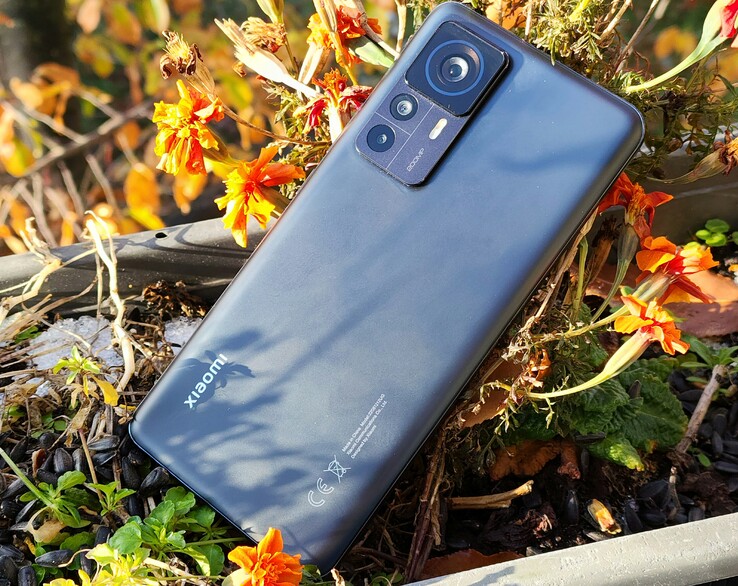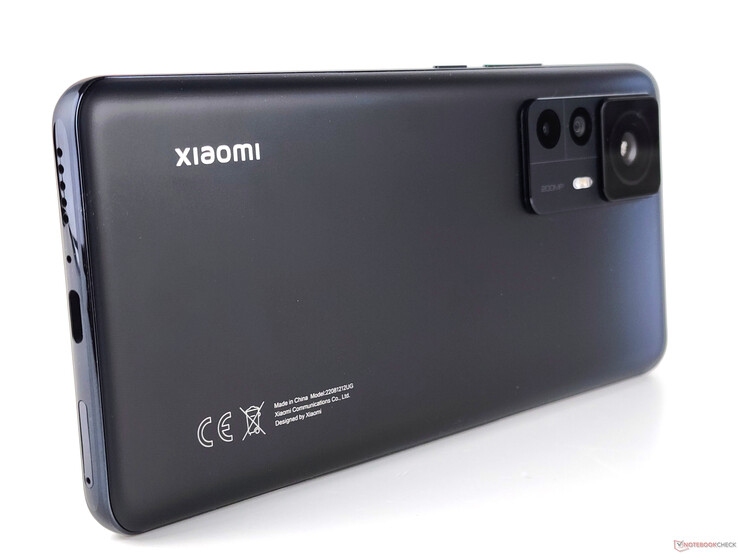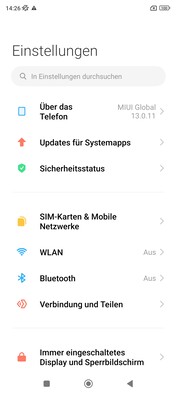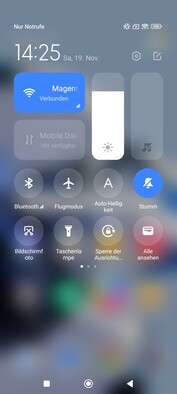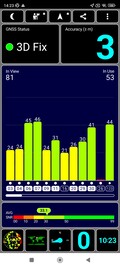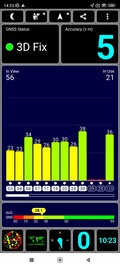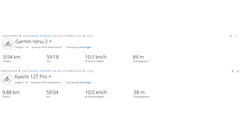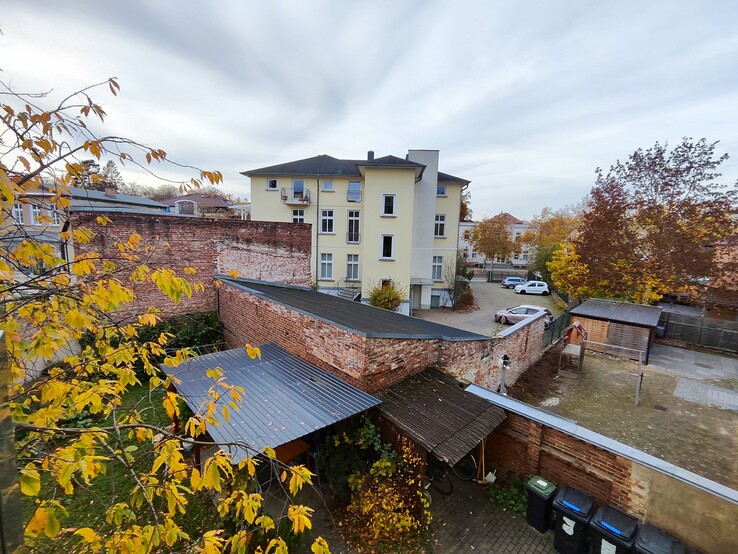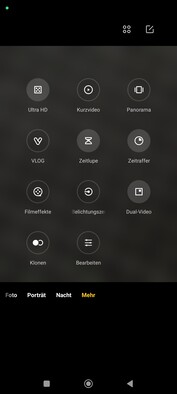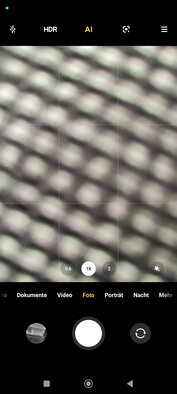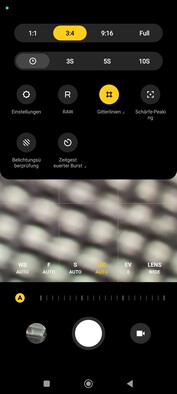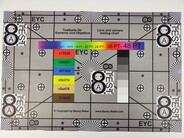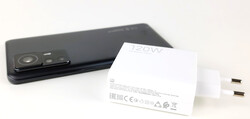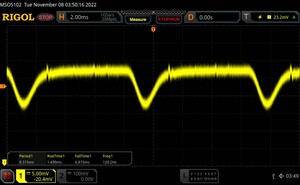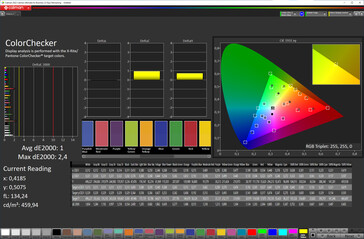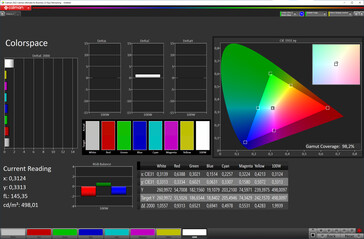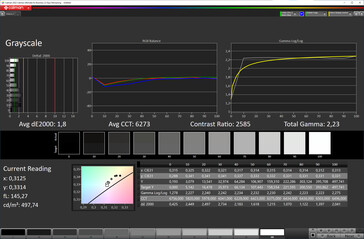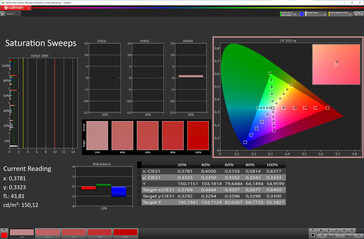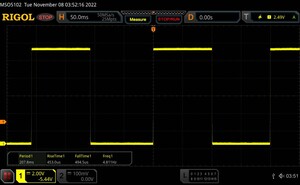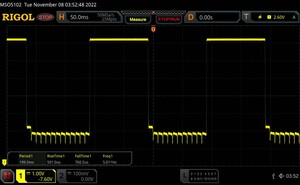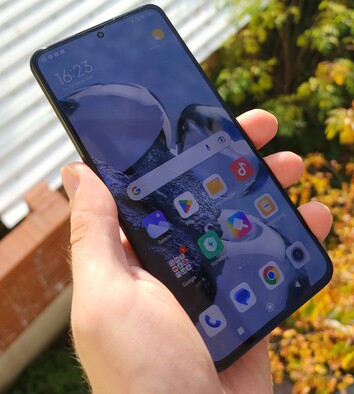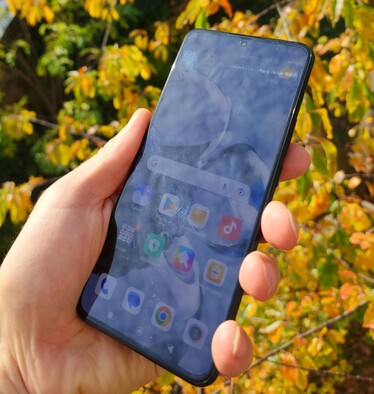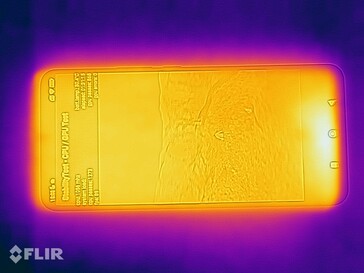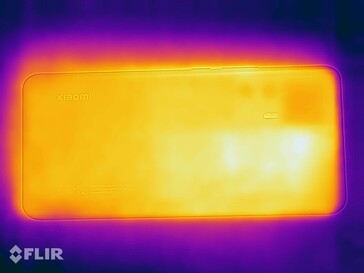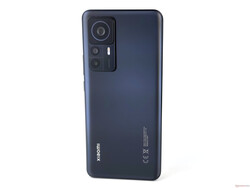Xiaomi 12T Pro 5G review: Smartphone with 200 MP and Snapdragon 8+ Gen1 at an attractive price
The Xiaomi 12T Pro offers flagship features in many areas at an attractive price. With its triple cam (including a 200 MP main camera), an efficient Qualcomm Snapdragon 8+ Gen 1, and its high-resolution (1,220p) 120 Hz OLED panel, the 12T Pro does not have to shy away from the competition. Particularly since the large 5,000 mAh battery can be charged very quickly with up to 120 watts in less than 20 minutes and a matching charger is even included in the scope of delivery.
The Chinese manufacturer lists its premium smartphone at an RRP of EUR 799.90 in Germany. In return, buyers of the T model get 8 GB of RAM and 256 GB of flash storage. A variant with greater storage capacity is not available.
Possible Competitors in Comparison
Rating | Date | Model | Weight | Drive | Size | Resolution | Price |
|---|---|---|---|---|---|---|---|
| 87.7 % v7 (old) | 11 / 2022 | Xiaomi 12T Pro 5G SD 8+ Gen 1, Adreno 730 | 205 g | 256 GB UFS 3.1 Flash | 6.67" | 2712x1220 | |
| 88.9 % v7 (old) | 05 / 2022 | Samsung Galaxy S22+ Exynos 2200, Xclipse 920 | 196 g | 128 GB UFS 3.1 Flash | 6.60" | 2340x1080 | |
| 87 % v7 (old) | 08 / 2022 | OnePlus 10T SD 8+ Gen 1, Adreno 730 | 203.5 g | 256 GB UFS 3.1 Flash | 6.70" | 2412x1080 | |
| 89.3 % v7 (old) | 10 / 2022 | Motorola Edge 30 Ultra SD 8+ Gen 1, Adreno 730 | 198.5 g | 256 GB UFS 3.1 Flash | 6.67" | 2400x1080 | |
| 87.6 % v7 (old) | 02 / 2022 | Xiaomi 12 Pro SD 8 Gen 1, Adreno 730 | 204 g | 256 GB UFS 3.1 Flash | 6.73" | 3200x1440 | |
| 89.1 % v7 (old) | 11 / 2022 | Google Pixel 7 Pro Tensor G2, Mali-G710 MP7 | 212 g | 128 GB UFS 3.1 Flash | 6.70" | 3120x1440 |
Case - Xiaomi smartphone without IP rating
The design of the Xiaomi 12T Pro is visually very reminiscent of its sibling, the Xiaomi 12 Pro, but the premium smartphone falls back on a plastic frame, and Gorilla Glass Victus is been replaced by the cheaper Gorilla Glass 5 to minimize costs. The build quality is nevertheless very good and the built-in keys sit comfortably firmly in the frame. Fingerprint residue is well concealed by the matte surface of the back.
In contrast to the 12 series, the casing of the 12T Pro does not have official IP certification. To what extent the high-end smartphone is sealed so that contact with water poses little danger, we do not know. But the SIM card slot features an orange accented rubber flap.
The form factor is almost identical between the Xiaomi 12 Pro and the 12T Pro, which means that the T model is also quite large. The display-to-front ratio is a solid 86.7% thanks to the moderate screen edges, although the display borders of the 12 Pro are even thinner.
Equipment - Xiaomi 12T Pro with IR Blaster
The 12T Pro offers fast 256 GB UFS 3.1 storage. The actual available storage is lower at 223 GB due to the operating system and some preinstalled apps. Those who need more space for videos or photos can only make use of external peripherals such as memory sticks via USB OTG, since memory expansion via micoSD cards is not possible.
Like the 12 Pro, the USB-C port of the 12T Pro only has the 2.0 standard, which means that wired image output is not possible with the high-end smartphone. On the other hand, the wireless transmission of display content to external monitors via Miracast is possible, and video content from streaming services can be viewed in HD quality thanks to Widevine L1.
Other features of the 12T Pro include an IR blaster, a color temperature sensor, NFC for contactless payment and Bluetooth 5.2.
Software - Xiaomi smartphone with 4 years of updates
Xiaomi combines the Android operating system with its in-house MIUI user interface in version 13, which is still based on Android 12. But the security patches from October 2022 are quite up-to-date.
The update guarantee of the Xiaomi 12 series, i.e. three major Android updates and four years of security updates, also applies to the T series - Xiaomi's premium smartphones will thus be updated up to Android 15. In the Android field, Samsung goes one better with its S-series: Buyers of a Galaxy S22 get four major Android updates as well as five years of security patches.
Communication & GNSS - Xiaomi smartphone with Wi-Fi 6
The Xiaomi 12T Pro deploys the MIMO method to ensure first-class 5G and Wi-Fi reception. As expected for a smartphone in this price range, the high-end smartphone uses Wi-Fi 6, but the 6 gigahertz frequency band cannot be used for WLAN transmissions.
The Wi-Fi 6E competition achieves significantly more bandwidth than the 12T Pro, but speeds are still acceptable for a premium smartphone. We measured a peak of over 800 MB/s in conjuction with our Asus ROG Rapture GT-AXE11000 reference router, but only averaged 672 MBit/s when receiving. In the home network, the Xiaomi smartphone scores with mostly constant transfer rates.
The 12T Pro supports all current mobile standards (including 5G) for mobile internet access. The range of frequencies is very extensive and users are very well positioned in Germany. At a total of 24 supported LTE bands, nothing stands in the way of a trip abroad with the T-model.
For localization, the Xiaomi 12T Pro uses a number of satellite systems, namely GPS (L1+L5), GLONASS (G1), BeiDou (B1+B2) and Galileo (E1+E5) as well as SBAS. In order to be able to assess real-world tracking accuracy, we took the high-end smartphone on a short bike ride and recorded the route in parallel with a Garmin Venu 2 for comparison purposes.
We like the tracking capabilities of the 12T Pro for the most part. However, deviations from the selected routes are sometimes clearly visible in the detailed view of the GPS recording. From time to time, the 12T Pro deviates from our actual path. Despite these minor inaccuracies, the Xiaomi smartphone is still well suited for navigation tasks.
Telephony & Voice Quality - Xiaomi 12T Pro with eSim
The Xiaomi smartphone supports dual-SIM use, based on two nano-SIM cards or a physical SIM card and an eSIM. Standards such as VoLTE or WLAN calls are supported.
The voice quality of the 12T Pro is inconspicuous. Voices are reproduced intelligibly and our call partner also confirms them as being very clear. Thanks to the installed microphones, the high-end smartphone does not show any weaknesses in regard to video conferencing - tested via Skype - and the dual speaker system.
Cameras - Xiaomi smartphone with 200 MP
Compared to the 11T Pro, this year's top-of-the-range smartphone has a relatively high-resolution 20 MP camera in the punch hole. The photo quality of the front camera with Sony's IMX596 is very solid in good lighting conditions in photo mode. Sharpness and color reproduction are also impressive on the 12T Pro. However, the 20-megapixel photos are not so convincing in portrait mode because the exposure is usually suboptimal and the sky appears overexposed.
As in the predecessor, Xiaomi also focuses on the main camera in the 12T Pro, which now has 200 MP instead of 108 MP. However, not much has changed in terms of the low-resolution ultra-wide-angle camera, together with a sensor from Samsung (S5K4H7): compromises have to be made here. The sharpness level in particular could be better.
As usual for this price range, the main camera has optical image stabilization and a large open aperture of f/1.69, so pictures in the dark are very well illuminated with pixel binning technology - at least in theory. The 12T Pro portrays subjects very softly in low light and we also see potential for improvement in terms of brightness.
Photos in daylight are very rich in contrast and detail with the Samsung image sensor (ISOCELL HP1). Subjects are displayed quite cool and are also subject to less post-photo sharpening than in the competition. However, the high-end smartphone from Xiaomi still has flaws in regard to exposure. Furthermore, photos in shadowy areas are a little grainy.
One strength of the 12T Pro is the short shutter release times thanks to the Ultra Burst feature - up to 30 photos per second can be taken here. Xiaomi's T model has virtually no shutter lag and reacts immediately to the shutter release. In this discipline, even a Samsung Galaxy S22 Ultra or Apple iPhone 14 Pro cannot keep up with the 12T Pro.
Moving pictures can be recorded at up to 8K at 24 fps - a higher refresh rate is possible with the UHD option (60 fps). During a running 1080p video recording, you can also switch between the main and ultra wide-angle lenses.
Image comparison
Choose a scene and navigate within the first image. One click changes the position on touchscreens. One click on the zoomed-in image opens the original in a new window. The first image shows the scaled photograph of the test device.
Wide angleWide angleLow light Zoom 5xUltra wide angleWhile the T-series cannot (yet) utilize the cooperation with German camera manufacturer Leica for the camera calibration, colors are still captured solidly, with the exception of the green tones. The color fidelity we measured under controlled lighting conditions shows only three outliers (>15). The analysis with the ColorChecker Passport compared to the actual reference colors reveals that the colors are oversaturated, but we also see potential for improvement in the grayscale.
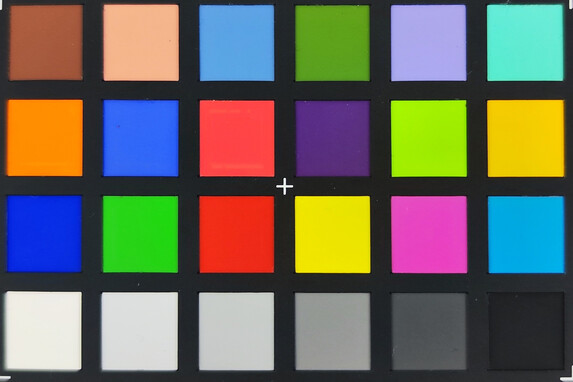

Accessories & Warranty - Xiaomi smartphone with power adapter
The 12T Pro's scope of delivery includes a modular 120-watt power supply, a data or charging cable, a protective case cover, a SIM pin and a quick start guide, including the warranty terms.
Xiaomi provides a warranty of 24 months on its smartphone in Germany and "exclusive" customer support, including an extra service hotline. There is also a limited warranty on defective screens, which includes a free screen repair within 6 months from the date of purchase. In addition, out-of-warranty labor costs will be charged within the first 12 months.
These warranty terms may differ from location to location, so be sure to check with your supplier before purchasing.
Input Devices & Operation - Xiaomi 12T Pro with 480 Hz
Inputs on the 6.67-inch OLED DotDisplay are accurately implemented right up to the touchscreen's corners. A protective film is applied ex-works, but it is rather prone to grease streaks. With a sampling rate of 480 Hz, the panel of the 12T Pro responds to touches with high sensitivity and refreshes up to 480 times per second, such as in games, which ensures low input latency. Xiaomi also installs a vibration motor that provides nice haptic feedback in everyday use.
The optical fingerprint sensor is integrated into the display and unlocks the premium phone very reliably and quickly, but the finger must be placed exactly on the marked area. A rather unsecure 2D facial recognition, which is based on a FaceUnlock function via the front camera, is also available. This often works faster than the fingerprint sensor in daylight.
Display - Xiaomi smartphone with 120 Hz
The 6.67-inch 20:9 AMOLED panel offers a frame rate of up to 120 Hz, with a rather unusual resolution of 2,712 x 1,220. The frame rate of the AdaptiveSync display can be manually or automatically reduced to 60 Hz to save power. However, the T-model does not have an LTPO panel with an adaptive frame rate controlled by the system, like in the 12 Pro.
In our brightness measurement, the OLED screen reaches around 900 cd/m² on a full white display, which is a good value for this price range. The APL18 measurement, which is more representative of everyday use, shows 901 cd/m² in the center of the screen. Also a satisfactory value, but a Galaxy S22+ is significantly brighter at around 1,500 cd/m².
Due to the installed display technology, Xiaomi uses PWM technology, including screen flickering, to control screen brightness. However, the amplitude curve is very uniform across the entire brightness spectrum and constant at 120 Hz - similar to a DC dimming mode ex-factory.
The Xiaomi smartphone showed no abnormalities in our temporal dithering test. For this, we examined the OLED display with a microscope during the playback of a 240 FPS slow-motion video.
| |||||||||||||||||||||||||
Brightness Distribution: 95 %
Center on Battery: 913 cd/m²
Contrast: ∞:1 (Black: 0 cd/m²)
ΔE ColorChecker Calman: 1 | ∀{0.5-29.43 Ø4.78}
ΔE Greyscale Calman: 1.8 | ∀{0.09-98 Ø5}
98.2% sRGB (Calman 2D)
Gamma: 2.23
CCT: 6273 K
| Xiaomi 12T Pro 5G AMOLED, 2712x1220, 6.7" | Samsung Galaxy S22+ AMOLED, 2340x1080, 6.6" | OnePlus 10T Fluid AMOLED, 2412x1080, 6.7" | Motorola Edge 30 Ultra pOLED, 2400x1080, 6.7" | Xiaomi 12 Pro AMOLED, 3200x1440, 6.7" | Google Pixel 7 Pro OLED, 3120x1440, 6.7" | |
|---|---|---|---|---|---|---|
| Screen | -32% | -45% | -2% | -5% | 15% | |
| Brightness middle (cd/m²) | 913 | 1090 19% | 861 -6% | 1020 12% | 959 5% | 1022 12% |
| Brightness (cd/m²) | 913 | 1097 20% | 856 -6% | 1020 12% | 977 7% | 1025 12% |
| Brightness Distribution (%) | 95 | 98 3% | 97 2% | 96 1% | 96 1% | 99 4% |
| Black Level * (cd/m²) | ||||||
| Colorchecker dE 2000 * | 1 | 2.5 -150% | 2.27 -127% | 1 -0% | 1.1 -10% | 0.9 10% |
| Colorchecker dE 2000 max. * | 2.4 | 3.8 -58% | 4.17 -74% | 2.8 -17% | 3.1 -29% | 2.1 12% |
| Greyscale dE 2000 * | 1.8 | 2.3 -28% | 2.9 -61% | 2.1 -17% | 1.9 -6% | 1.1 39% |
| Gamma | 2.23 99% | 2.04 108% | 2.303 96% | 2.29 96% | 2.22 99% | 2.22 99% |
| CCT | 6273 104% | 6492 100% | 6141 106% | 6502 100% | 6498 100% | 6650 98% |
* ... smaller is better
Screen Flickering / PWM (Pulse-Width Modulation)
| Screen flickering / PWM detected | 120 Hz | ||
The display backlight flickers at 120 Hz (worst case, e.g., utilizing PWM) . The frequency of 120 Hz is very low, so the flickering may cause eyestrain and headaches after extended use. In comparison: 53 % of all tested devices do not use PWM to dim the display. If PWM was detected, an average of 8111 (minimum: 5 - maximum: 343500) Hz was measured. | |||
Series of measurements at a fixed zoom level and different brightness settings
In addition to strong contrasts, the Xiaomi 12T Pro with HDR10+ offers a large dynamic range and high color space coverage. Practically no color differences to the reference are visible in sRGB. The OLED panel is very well calibrated ex works, which was confirmed by our analysis with a photospectrometer. The CalMAN software shows very low average DeltaE deviations of 1.0 (colors) and 1.8 (grayscale). However, the smaller sRGB color space has to be selected in the settings in order to achieve the high accuracy.
In terms of adaptability, the MIUI operating system is exemplary. In addition to 3 color profiles, users can individually adjust individual parameters, such as color space or the saturation- and gamma values, in the advanced settings. The 12T Pro also offers an adaptive color mode.
Display Response Times
| ↔ Response Time Black to White | ||
|---|---|---|
| 0.95 ms ... rise ↗ and fall ↘ combined | ↗ 0.453 ms rise | |
| ↘ 0.4945 ms fall | ||
| The screen shows very fast response rates in our tests and should be very well suited for fast-paced gaming. In comparison, all tested devices range from 0.1 (minimum) to 240 (maximum) ms. » 3 % of all devices are better. This means that the measured response time is better than the average of all tested devices (20.2 ms). | ||
| ↔ Response Time 50% Grey to 80% Grey | ||
| 1.26 ms ... rise ↗ and fall ↘ combined | ↗ 0.501 ms rise | |
| ↘ 0.7605 ms fall | ||
| The screen shows very fast response rates in our tests and should be very well suited for fast-paced gaming. In comparison, all tested devices range from 0.165 (minimum) to 636 (maximum) ms. » 5 % of all devices are better. This means that the measured response time is better than the average of all tested devices (31.6 ms). | ||
Performance - Xiaomi Phone with Qualcomm SoC
The Snapdragon 8+ Gen. 1 in the 12T Pro is the best of the best in the Android field. The 4nm SoC is based on three clusters, which consist of a prime core (Cortex X2), three performance cores (Cortex A710) and four power-saving units (Cortex A510). The processor can also use the integrated Adreno 730 for graphics acceleration.
In the CPU and system benchmarks, the Xiaomi smartphone delivers very good performance values. Only in the system benchmarks of PCMark and Crossmark does the 12T Pro "weaken" a little. Otherwise it also performs very strongly in the UL Procyon AI Inference Benchmark, which measures AI performance.
| UL Procyon AI Inference for Android - Overall Score NNAPI | |
| Xiaomi 12T Pro 5G | |
| Xiaomi 12 Pro | |
| Average Qualcomm Snapdragon 8+ Gen 1 (3291 - 84787, n=21) | |
| Google Pixel 7 Pro | |
| Average of class Smartphone (3769 - 81594, n=139, last 2 years) | |
| Motorola Edge 30 Ultra | |
| OnePlus 10T | |
| AImark - Score v2.x | |
| Xiaomi 12 Pro | |
| Xiaomi 12T Pro 5G | |
| OnePlus 10T | |
| Average Qualcomm Snapdragon 8+ Gen 1 (1043 - 7865, n=11) | |
| Samsung Galaxy S22+ | |
| Motorola Edge 30 Ultra | |
| Google Pixel 7 Pro | |
Th Adreno 730 also impresses with very high performance values. Particularly in the offscreen of the GFX, the 12T Pro performs really well. However, it cannot match the onscreen rates of the 1080p competition, such as Motorola's Edge 30 Ultra, due to the slightly higher resolution.
GFXBench (DX / GLBenchmark) 2.7: T-Rex Onscreen | 1920x1080 T-Rex Offscreen
GFXBench 3.0: on screen Manhattan Onscreen OGL | 1920x1080 1080p Manhattan Offscreen
GFXBench 3.1: on screen Manhattan ES 3.1 Onscreen | 1920x1080 Manhattan ES 3.1 Offscreen
GFXBench: on screen Car Chase Onscreen | 1920x1080 Car Chase Offscreen | on screen Aztec Ruins High Tier Onscreen | 2560x1440 Aztec Ruins High Tier Offscreen | on screen Aztec Ruins Normal Tier Onscreen | 1920x1080 Aztec Ruins Normal Tier Offscreen
| 3DMark / Wild Life Extreme Unlimited | |
| OnePlus 10T | |
| Motorola Edge 30 Ultra | |
| Xiaomi 12T Pro 5G | |
| Xiaomi 12 Pro | |
| Samsung Galaxy S22+ | |
| Google Pixel 7 Pro | |
| 3DMark / Wild Life Extreme | |
| OnePlus 10T | |
| Motorola Edge 30 Ultra | |
| Xiaomi 12T Pro 5G | |
| Xiaomi 12 Pro | |
| Samsung Galaxy S22+ | |
| Google Pixel 7 Pro | |
| 3DMark / Wild Life Unlimited Score | |
| Xiaomi 12T Pro 5G | |
| OnePlus 10T | |
| Motorola Edge 30 Ultra | |
| Xiaomi 12 Pro | |
| Samsung Galaxy S22+ | |
| Google Pixel 7 Pro | |
| GFXBench (DX / GLBenchmark) 2.7 / T-Rex Onscreen | |
| Motorola Edge 30 Ultra | |
| Xiaomi 12 Pro | |
| Google Pixel 7 Pro | |
| Xiaomi 12T Pro 5G | |
| Samsung Galaxy S22+ | |
| OnePlus 10T | |
| GFXBench (DX / GLBenchmark) 2.7 / T-Rex Offscreen | |
| Xiaomi 12T Pro 5G | |
| Motorola Edge 30 Ultra | |
| OnePlus 10T | |
| Xiaomi 12 Pro | |
| Samsung Galaxy S22+ | |
| Google Pixel 7 Pro | |
| GFXBench 3.0 / Manhattan Onscreen OGL | |
| Motorola Edge 30 Ultra | |
| Xiaomi 12T Pro 5G | |
| Samsung Galaxy S22+ | |
| Xiaomi 12 Pro | |
| Google Pixel 7 Pro | |
| OnePlus 10T | |
| GFXBench 3.0 / 1080p Manhattan Offscreen | |
| Xiaomi 12T Pro 5G | |
| Xiaomi 12 Pro | |
| Motorola Edge 30 Ultra | |
| OnePlus 10T | |
| Samsung Galaxy S22+ | |
| Google Pixel 7 Pro | |
| GFXBench 3.1 / Manhattan ES 3.1 Onscreen | |
| Motorola Edge 30 Ultra | |
| Xiaomi 12T Pro 5G | |
| Samsung Galaxy S22+ | |
| Xiaomi 12 Pro | |
| OnePlus 10T | |
| Google Pixel 7 Pro | |
| GFXBench 3.1 / Manhattan ES 3.1 Offscreen | |
| Xiaomi 12T Pro 5G | |
| Motorola Edge 30 Ultra | |
| OnePlus 10T | |
| Xiaomi 12 Pro | |
| Samsung Galaxy S22+ | |
| Google Pixel 7 Pro | |
| GFXBench / Car Chase Onscreen | |
| Motorola Edge 30 Ultra | |
| Xiaomi 12T Pro 5G | |
| Samsung Galaxy S22+ | |
| OnePlus 10T | |
| Google Pixel 7 Pro | |
| Xiaomi 12 Pro | |
| GFXBench / Car Chase Offscreen | |
| OnePlus 10T | |
| Xiaomi 12T Pro 5G | |
| Motorola Edge 30 Ultra | |
| Samsung Galaxy S22+ | |
| Xiaomi 12 Pro | |
| Google Pixel 7 Pro | |
| GFXBench / Aztec Ruins High Tier Onscreen | |
| Motorola Edge 30 Ultra | |
| OnePlus 10T | |
| Samsung Galaxy S22+ | |
| Xiaomi 12T Pro 5G | |
| Google Pixel 7 Pro | |
| Xiaomi 12 Pro | |
| GFXBench / Aztec Ruins High Tier Offscreen | |
| Motorola Edge 30 Ultra | |
| OnePlus 10T | |
| Xiaomi 12T Pro 5G | |
| Xiaomi 12 Pro | |
| Samsung Galaxy S22+ | |
| Google Pixel 7 Pro | |
| GFXBench / Aztec Ruins Normal Tier Onscreen | |
| Motorola Edge 30 Ultra | |
| Xiaomi 12T Pro 5G | |
| Samsung Galaxy S22+ | |
| OnePlus 10T | |
| Xiaomi 12 Pro | |
| Google Pixel 7 Pro | |
| GFXBench / Aztec Ruins Normal Tier Offscreen | |
| OnePlus 10T | |
| Motorola Edge 30 Ultra | |
| Xiaomi 12T Pro 5G | |
| Xiaomi 12 Pro | |
| Google Pixel 7 Pro | |
| Samsung Galaxy S22+ | |
In the browser benchmarks, the high-end smartphone from Xiaomi ranks in the lower midfield. But users of the 12T Pro are unlikely to notice the difference in everyday life. Scrolling is smooth and the loading times are good.
| Jetstream 2 - 2.0 Total Score | |
| Average of class Smartphone (23.8 - 387, n=154, last 2 years) | |
| Average Qualcomm Snapdragon 8+ Gen 1 (76.2 - 204, n=23) | |
| Motorola Edge 30 Ultra (Chrome 105) | |
| Samsung Galaxy S22+ (Chrome 100.0.4896.127) | |
| Xiaomi 12T Pro 5G (Chrome 107) | |
| Google Pixel 7 Pro (Chrome 106) | |
| Xiaomi 12 Pro (Chrome 97) | |
| OnePlus 10T (Chrome 104) | |
| Speedometer 2.0 - Result 2.0 | |
| Average of class Smartphone (15.2 - 643, n=128, last 2 years) | |
| Average Qualcomm Snapdragon 8+ Gen 1 (69.1 - 196, n=18) | |
| Samsung Galaxy S22+ (Chrome 100.0.4896.127) | |
| Google Pixel 7 Pro (Chrome 106) | |
| Motorola Edge 30 Ultra (Chrome 105) | |
| OnePlus 10T (Chrome 104) | |
| Xiaomi 12 Pro (Chrome 97) | |
| Xiaomi 12T Pro 5G (Chrome 107) | |
| WebXPRT 4 - Overall | |
| Average of class Smartphone (27 - 306, n=148, last 2 years) | |
| Average Qualcomm Snapdragon 8+ Gen 1 (69 - 159, n=21) | |
| Motorola Edge 30 Ultra (Chrome 105) | |
| Xiaomi 12T Pro 5G (Chrome 107) | |
| Google Pixel 7 Pro (Chrome 106) | |
| OnePlus 10T | |
| WebXPRT 3 - Overall | |
| Average of class Smartphone (38 - 380, n=35, last 2 years) | |
| Average Qualcomm Snapdragon 8+ Gen 1 (106 - 224, n=14) | |
| Samsung Galaxy S22+ (Chrome 100.0.4896.127) | |
| Motorola Edge 30 Ultra (Chrome 105) | |
| Xiaomi 12 Pro (Chrome 97) | |
| Xiaomi 12T Pro 5G (Chrome 107) | |
| OnePlus 10T (Chrome 104) | |
| Google Pixel 7 Pro (Chrome 106) | |
| Octane V2 - Total Score | |
| Average of class Smartphone (2228 - 121337, n=201, last 2 years) | |
| Samsung Galaxy S22+ (Chrome 100.0.4896.127) | |
| Google Pixel 7 Pro (Chrome 106) | |
| Average Qualcomm Snapdragon 8+ Gen 1 (17622 - 61536, n=24) | |
| OnePlus 10T (Chrome 104) | |
| Motorola Edge 30 Ultra (Chrome 105) | |
| Xiaomi 12T Pro 5G (Chrome 107) | |
| Xiaomi 12 Pro (Chrome 97) | |
| Mozilla Kraken 1.1 - Total | |
| OnePlus 10T (Chrome 104) | |
| Samsung Galaxy S22+ (Chrome 100.0.4896.127) | |
| Xiaomi 12 Pro (Chrome 97) | |
| Xiaomi 12T Pro 5G (Chrome 107) | |
| Average of class Smartphone (257 - 28190, n=156, last 2 years) | |
| Motorola Edge 30 Ultra (Chrome 105) | |
| Average Qualcomm Snapdragon 8+ Gen 1 (665 - 1707, n=22) | |
| Google Pixel 7 Pro (Chrome 106) | |
* ... smaller is better
The operating speed of the Xiaomi smartphone is pleasantly high, and there are almost no delays. The loading times of applications are also very short. The latter is also due to the high speed of the UFS storage. Write rates in particular are excellent in the 12T Pro.
| Xiaomi 12T Pro 5G | Samsung Galaxy S22+ | OnePlus 10T | Motorola Edge 30 Ultra | Xiaomi 12 Pro | Google Pixel 7 Pro | Average 256 GB UFS 3.1 Flash | Average of class Smartphone | |
|---|---|---|---|---|---|---|---|---|
| AndroBench 3-5 | -34% | -48% | -18% | -19% | -46% | -29% | -13% | |
| Sequential Read 256KB (MB/s) | 1870.78 | 1629.99 -13% | 1568.37 -16% | 1717.77 -8% | 1620 -13% | 1346.78 -28% | 1757 ? -6% | 2223 ? 19% |
| Sequential Write 256KB (MB/s) | 1726.23 | 1001.67 -42% | 847.69 -51% | 1363.58 -21% | 1465 -15% | 874.73 -49% | 1204 ? -30% | 1838 ? 6% |
| Random Read 4KB (MB/s) | 543.38 | 306.7 -44% | 173.45 -68% | 349.08 -36% | 324.9 -40% | 219.01 -60% | 287 ? -47% | 295 ? -46% |
| Random Write 4KB (MB/s) | 483.87 | 297.67 -38% | 211.24 -56% | 446.25 -8% | 448.9 -7% | 253.18 -48% | 318 ? -34% | 335 ? -31% |
Gaming - Xiaomi 12T Pro unable to manage 120 fps
In order to assess the GPU power in gaming as well as in benchmarks, we took a closer look at two Android titles from the Play Store with the software from our partner GameBench.
Both Android games run smoothly and without major frame drops - as is to be expected from a Snapdragon.8+ Gen 1. On PUBG Mobile, however, the Chinese manufacturer imposes a 60 fps limit, regardless of which graphics setting we choose - with the exception of UHD mode. Here the 12T Pro runs at just 40 fps.
In Armajet, which theoretically supports up to 144 FPS, a maximum of 103 fps is available. However, the 12T Pro only manages a moderate 63 fps on average. Even inexpensive mid-range SoCs, such as the Snapdragon 695, achieve more than 80 fps on average in the 2D multiplayer shooter. This doesn't seem to have anything to do with the waste heat because the case only gets warm at most during gaming, never hot.
Emissions - Xiaomi smartphone barely gets warm
Temperature
The liquid cooling system, consisting of an evaporative cooling chamber and multilayer graphite plates, keeps the surface temperatures of the case well under control in everyday use. For a smartphone with a Snapdragon 8+ Gen1, the 12T Pro remains comparatively cool under load.
The high-end Xiaomi smartphone is able to complete the battery test of GFXBench in the demanding Manhattan test (OpenGL ES 3.1), but does not provide results for evaluation. The Wild Life Stress tests of 3DMark reveal a reduction in performance on part of the Qualcomm SoC, but the consistency is still very impressive for a smartphone powered by a Snapdragon 8+ Gen1. Xiaomi has done a very good job here, especially in view of the results of the Motorola Edge 30 Ultra.
(+) The maximum temperature on the upper side is 31.9 °C / 89 F, compared to the average of 35.2 °C / 95 F, ranging from 21.9 to 247 °C for the class Smartphone.
(+) The bottom heats up to a maximum of 29.9 °C / 86 F, compared to the average of 34 °C / 93 F
(+) In idle usage, the average temperature for the upper side is 30.1 °C / 86 F, compared to the device average of 32.9 °C / 91 F.
3DMark Wild Life Stress Test
| 3DMark | |
| Wild Life Stress Test Stability | |
| OnePlus 10T | |
| Xiaomi 12T Pro 5G | |
| Google Pixel 7 Pro | |
| Motorola Edge 30 Ultra | |
| Samsung Galaxy S22+ | |
| Xiaomi 12 Pro | |
| Wild Life Extreme Stress Test | |
| Xiaomi 12T Pro 5G | |
| Google Pixel 7 Pro | |
| Motorola Edge 30 Ultra | |
| Samsung Galaxy S22+ | |
| Xiaomi 12 Pro | |
| OnePlus 10T | |
Speakers
As in the 12 Pro, the two stereo speakers of the Xiaomi smartphone have been optimized by Harman Kardon. The two speakers deliver a maximum volume of over 90 dB and very decent sound. However, both the lower mids and the highs are a little lacking in terms of overall sound quality.
In addition to a wide range of Bluetooth codecs, including SBC, AAC, aptX, aptX HD, aptX Adaptive, aptX TWS+, LDAC and LHDC, headphones can also be connected via the USB-C port.
Xiaomi 12T Pro 5G audio analysis
(+) | speakers can play relatively loud (90.1 dB)
Bass 100 - 315 Hz
(-) | nearly no bass - on average 25.2% lower than median
(±) | linearity of bass is average (8.4% delta to prev. frequency)
Mids 400 - 2000 Hz
(±) | reduced mids - on average 5.7% lower than median
(+) | mids are linear (4.4% delta to prev. frequency)
Highs 2 - 16 kHz
(±) | higher highs - on average 5.4% higher than median
(+) | highs are linear (3.6% delta to prev. frequency)
Overall 100 - 16.000 Hz
(±) | linearity of overall sound is average (18.5% difference to median)
Compared to same class
» 20% of all tested devices in this class were better, 9% similar, 71% worse
» The best had a delta of 11%, average was 35%, worst was 134%
Compared to all devices tested
» 40% of all tested devices were better, 8% similar, 52% worse
» The best had a delta of 4%, average was 24%, worst was 134%
Google Pixel 7 Pro audio analysis
(+) | speakers can play relatively loud (88.4 dB)
Bass 100 - 315 Hz
(-) | nearly no bass - on average 17.4% lower than median
(±) | linearity of bass is average (13% delta to prev. frequency)
Mids 400 - 2000 Hz
(+) | balanced mids - only 3.8% away from median
(+) | mids are linear (6.7% delta to prev. frequency)
Highs 2 - 16 kHz
(±) | higher highs - on average 8.8% higher than median
(±) | linearity of highs is average (9% delta to prev. frequency)
Overall 100 - 16.000 Hz
(±) | linearity of overall sound is average (16.8% difference to median)
Compared to same class
» 8% of all tested devices in this class were better, 7% similar, 85% worse
» The best had a delta of 11%, average was 35%, worst was 134%
Compared to all devices tested
» 29% of all tested devices were better, 7% similar, 64% worse
» The best had a delta of 4%, average was 24%, worst was 134%
Battery life - Xiaomi smartphone recharges rapidly
Power Consumption
The battery of the Xiaomi 12T Pro has a capacity of 5,000 mAh and can be charged with the in-house HyperCharge technology with a maximum of 120 watts. A full charge took around 20 minutes in our test. The energy capacity is monitored by 9 thermal sensors that control the connector and the battery during the charging process. Xiaomi guarantees 800 charging cycles, which is significantly less than other manufacturers. OnePlus, for example, claims a battery life of 1,600 cycles for its 10T model, which is also charged with a high 150 watts. Wireless charging has been omitted from the 12T Pro to reduce costs compared to the Xiaomi 12 Pro.
The power consumption of the Xiaomi smartphone is not completely convincing. The average power consumption of 1.7 watts in idle mode is quite high. Under load, however, the Snapdragon 8+ Gen 1 draws similar amounts of power as the Qualcomm competition.
| Off / Standby | |
| Idle | |
| Load |
|
Key:
min: | |
| Xiaomi 12T Pro 5G 5000 mAh | Samsung Galaxy S22+ 4500 mAh | OnePlus 10T 4800 mAh | Motorola Edge 30 Ultra 4610 mAh | Xiaomi 12 Pro 4600 mAh | Google Pixel 7 Pro 5000 mAh | Average Qualcomm Snapdragon 8+ Gen 1 | Average of class Smartphone | |
|---|---|---|---|---|---|---|---|---|
| Power Consumption | -22% | 13% | 9% | -12% | 6% | -29% | -35% | |
| Idle Minimum * (Watt) | 1.05 | 0.71 32% | 0.8 24% | 0.74 30% | 0.94 10% | 0.78 26% | 1.006 ? 4% | 0.848 ? 19% |
| Idle Average * (Watt) | 1.65 | 1.1 33% | 1.2 27% | 1.84 -12% | 1.24 25% | 1.61 2% | 1.834 ? -11% | 1.434 ? 13% |
| Idle Maximum * (Watt) | 1.72 | 1.19 31% | 1.3 24% | 1.86 -8% | 1.34 22% | 1.63 5% | 1.984 ? -15% | 1.618 ? 6% |
| Load Average * (Watt) | 3.12 | 7.74 -148% | 3.5 -12% | 2.75 12% | 5.7 -83% | 3.29 -5% | 5.68 ? -82% | 7.01 ? -125% |
| Load Maximum * (Watt) | 6.02 | 9.64 -60% | 5.9 2% | 4.54 25% | 8.12 -35% | 6.01 -0% | 8.44 ? -40% | 11.3 ? -88% |
* ... smaller is better
Power Consumption: Geekbench (150 cd/m²)
Power Consumption: GFXBench (150 cd/m²)
Battery Life
The Xiaomi 12T Pro delivers good runtimes at a fixed 120 Hz refresh rate in our two real-world battery tests, which are performed at an adjusted display brightness of 150 cd/m².
In the WLAN test, the high-end smartphone manages over 18 hours, and even 3.5 hours more in endless video playback with the WLAN module disabled. Compared to a Xiaomi 12 Pro, this results in a runtime increase of over 30%.
| Xiaomi 12T Pro 5G 5000 mAh | Samsung Galaxy S22+ 4500 mAh | OnePlus 10T 4800 mAh | Motorola Edge 30 Ultra 4610 mAh | Xiaomi 12 Pro 4600 mAh | Google Pixel 7 Pro 5000 mAh | |
|---|---|---|---|---|---|---|
| Battery runtime | 3% | 3% | -0% | -12% | -26% | |
| Reader / Idle (h) | 29.2 | 42.9 47% | 29.9 2% | 36.8 26% | 33.9 16% | 20.2 -31% |
| H.264 (h) | 21.4 | 17 -21% | 27.4 28% | 19.8 -7% | 13.1 -39% | 20.2 -6% |
| WiFi v1.3 (h) | 18.1 | 13.1 -28% | 14.3 -21% | 14.5 -20% | 12.8 -29% | 11.3 -38% |
| Load (h) | 5.4 | 6.1 13% | 5.5 2% | 5.4 0% | 5.6 4% | 3.8 -30% |
Pros
Cons
Verdict on the Xiaomi 12T Pro 5G
The Xiaomi 12T Pro is a powerful high-end smartphone with an interesting strength-weakness profile. On the one hand, the T-model features sensible improvements compared to the Xiaomi 12 Pro, such as a new 200 MP sensor from Samsung, an efficient Snapdragon 8+ Gen 1 and eSIM support. On the other hand, the RRP is lower than that of the manufacturer's flagship series and the cooling is much better, which results in more consistent performance values. However, users looking for something for gaming will not be happy with the Xiaomi 12T Pro despite the strong SoC - we recommend taking a look at the Asus ROG Phone 6.
Compared to the Xiaomi 12 Pro, the T model has to make concessions in regard to the lack of IP certification and wireless charging. The Xiaomi 12T Pro also does not have a lot to offer in terms of design and feel with its thicker display edges, plastic frame and Gorilla Glass 5. Those who value these aspects will find an interesting alternative in the Motorola Edge 30 Ultra, which is also equipped with a 200 MP camera.
The SoC upgrade and the improved cooling of the Xiaomi 12T Pro make for excellent runtimes.
The highlight of Xiaomi's upper class smartphone, the 200 MP camera, impresses with beautiful display quality in daylight. However, we would have wished for slightly better low-light performance in this price range, since compromises already have to be made in the absence of a telephoto lens and a solid ultra-wide-angle lens. Google offers the better camera package in the Pixel 7 Pro in the upper-class range.
Price and Availability
As the Xiaomi 12T Pro 5G was only launched on October 6, availability may not be guaranteed at your location. Amazon USA lists the variant for 729,00$. On the other side of the Atlantic, it appears to be temporarily unavailable in the UK, while Amazon France offers the smartphone at 695,50€.
Prices are as of 24.11.2022 and subject to change.
Xiaomi 12T Pro 5G
- 11/23/2022 v7 (old)
Marcus Herbrich




